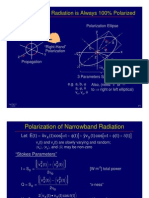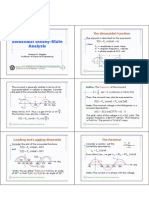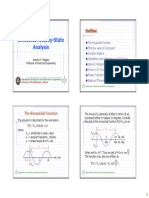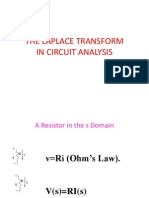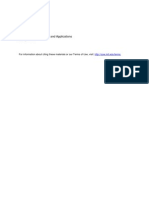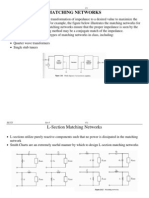Smith Chart Examples
Uploaded by
SheelaGouderSmith Chart Examples
Uploaded by
SheelaGouderSmith chart
The Smith Chart: allows to compute the input impedance to a transmission line
( )
( )
( )
0 0
1 0 1
0
1 0 1
in
in in
in
Z z Z Z Z
( (
+ +
= = = =
( (
The load reflection coefficient and the input coefficient are related as
4
2
j
j
in L L
e e
= =
We write the normalized input impedance
0
1
in
in
in
in
Z
z r jx
Z
(
+
= = = +
(
And the reflection coefficient as
4
j
in L
e p jq
= = +
Combining both equations
1
1
in
p jq
z r jx
p jq
+ +
= + =
Solving the real and imaginary parts
( )
2
2
2
1
1
1
r
p q
r
r
| |
+ =
|
+
\ +
( )
2
2
2
1 1
1 p q
x x
| |
+ =
|
\
Circles of radius
( )
1
1 r +
centered at
0
1
r
p q
r
= =
+
Circles of radius
1
x
centered at
1
1 p and q
x
= =
EE 342Spring 2010 #115
( )
2
2
2
1
1
1
r
p q
r
r
| |
+ =
|
+
\ +
Circles of radius
( )
1
1 r +
centered at 0
1
r
p and q
r
= =
+
( )
2
2
2
1 1
1 p q
x x
| |
+ =
|
\
Circles of radius
1
x
centered at
1
1 p and q
x
= =
EE 342Spring 2010 #116
Smith chart
The graphs relate the real and imaginary part of the reflection coefficient at a point (p,q)
with the real and imaginary part of the normalized input impedance (r,x)
EE 342Spring 2010 #117
Smith chart
Relation between the normalized input impedance to the line and the reflection coefficient
We plot the normalized input impedance
in
z r jx = +
The point defines the magnitude and
the angle of the reflection coefficient
2 2
in
p q = +
( )
2 4
in
= =
EE 342Spring 2010 #118
Smith chart
1
1
in
p jq
z r jx
p jq
+ +
= + =
4
j
in L
e p jq
= = +
How determine the input
impedance
We plot the normalized load impedance
0
L
L L L
Z
z r j x
Z
= = +
Rotate (with a compass) an angle
( )
2 4
in
= =
Clockwise TG (towards generator)
If we know the input impedance we calculate
0
in
in in in
Z
z r jx
Z
= = +
Rotate (with a compass) an angle
( )
2 4
in
= =
Counterclockwise TL (towards load)
EE 342Spring 2010 #119
Smith chart
Example: a coaxial cable (
r
= 2.25), length 10m. Frequency source 34 MHz. The
characteristic impedance is Z
0
= 50 . The line is terminated with a load Z
L
= (50+j100) .
Determine the input impedance
Propagation velocity
8
0
2 10
r
v
m
v
s
= =
Wavelength
5.882 1.7
v
m
f
= = =
Normalized load impedance
50 100
1 2
50
L
j
z j
+
= = +
Rotate 1.7 TG (3 turns plus 0.2 )
0.29 0.82
in
z j =
And unnormalizing
0
14.5 41
in in
Z z Z j = =
EE 342Spring 2010 #120
Smith chart
A B
C
D
E
Exercise:
Match the following
normalized impedances
with points A,B,C,D and E
on the Smith chart
i) 0+j0
ii) 1+j0
iii) 0-j1
iv) 0+j1
v) +j
vi)
vii)
viii) Matched load
min
in
C
Z
Z
(
(
max
in
C
Z
Z
(
(
( ) 0 =
i) D
ii) A
iii) E
iv) C
v) B
vi) D
vii) B
viii) A
EE 342Spring 2010 #121
Smith chart
Example:
( )
20 40
in
Z j =
( )
20 40
L
Z j = +
0
100 Z =
( )
0.2 0.4
in
z j =
We calculate
( )
0.2 0.4
L
z j = +
Determine the length
of the line in
wavelengths
0.062 TG
0.436 TG
0.436 0.062 0.374 = =
0.438 TL
0.064 TL
0.438 0.064 0.374 = =
EE 342Spring 2010 #122
Smith chart
Exercise: Determine Z
L
attached to
a line with Z
0
= 100 . Removing
the load yields an input impedance
Z
in
= -j80.With the unknown
impedance attached the input
impedance is (30 + j 40) .
Determine Z
L
With open circuit
80
0.8
100
L
in
Z
j
z j
=
= =
0.107 TL
0.393 TG
L
z =
0.25 TL
0.25 TG
( )
0.393 0.25 0.143 = =
( )
0.25 0.107 0.143 = =
With the load attached
( )
30 40
0.30 0.40
100
L
in
Z
j
z j
+
= = +
0.065 TG
0.435 TL
Rotate TL 0.143
0.435 + 0.143 = 0.578 = 0.078
0.32 0.49 32 49
L L
z j Z j = =
EE 342Spring 2010 #123
Smith chart
Exercise: Determine the load
impedance, VSWR and load
reflection coefficient for :
( )
50 100
in
Z j =
0
50 Z = 0.4 =
1 2
in
z j =
0.187 TL
45
0
Rotate TL (CCW)
0.187 0.4 0.587 0.087 + = =
0.22 0.58
L
z j =
( )
11 29
L
Z j =
-118
0
0
0.73 118
L
=
7 VSWR =
EE 342Spring 2010 #124
Smith chart
You might also like
- Engineering Academy: MOCK GATE (2012) - 2No ratings yetEngineering Academy: MOCK GATE (2012) - 212 pages
- Handout 5 - Introduction To Smith ChartNo ratings yetHandout 5 - Introduction To Smith Chart10 pages
- Monochromatic Radiation is Always 100% Polarized: Polarization Ellipse y θNo ratings yetMonochromatic Radiation is Always 100% Polarized: Polarization Ellipse y θ22 pages
- Frequency Response Analysis: Sinusoidal Forcing of A First-Order ProcessNo ratings yetFrequency Response Analysis: Sinusoidal Forcing of A First-Order Process27 pages
- Chapter 7 Sinusoidal Steady-State AnalysisNo ratings yetChapter 7 Sinusoidal Steady-State Analysis24 pages
- EEE3 Lecture 5 - Exam2 - Sinusoidal Steady-State AnalysisNo ratings yetEEE3 Lecture 5 - Exam2 - Sinusoidal Steady-State Analysis36 pages
- Ecse 353 Electromagnetic Fields and Waves Formulas: V) V + V V V V 0No ratings yetEcse 353 Electromagnetic Fields and Waves Formulas: V) V + V V V V 06 pages
- DT - NU-EEE342-Lecture 4-Smith Charts 2017 PDF100% (1)DT - NU-EEE342-Lecture 4-Smith Charts 2017 PDF62 pages
- Detailed Solution of IES 2103 (ECE) Objective Paper - I: Set - A'No ratings yetDetailed Solution of IES 2103 (ECE) Objective Paper - I: Set - A'12 pages
- Note 4 Transmission Lines (Bounce Diagram)No ratings yetNote 4 Transmission Lines (Bounce Diagram)31 pages
- Brilliant'S Progressive Test: Our One/Two-Year Postal Courses All India Engineering Entrance Examination, 2012No ratings yetBrilliant'S Progressive Test: Our One/Two-Year Postal Courses All India Engineering Entrance Examination, 201211 pages
- Sinusoidal Steady State-Mcqs: 1. The Value of Current Through The 1 Farad Capacitor of Figure IsNo ratings yetSinusoidal Steady State-Mcqs: 1. The Value of Current Through The 1 Farad Capacitor of Figure Is13 pages
- 6.013 Electromagnetics and Applications: Mit OpencoursewareNo ratings yet6.013 Electromagnetics and Applications: Mit Opencourseware13 pages
- Control Por Computador: January 15, 2014No ratings yetControl Por Computador: January 15, 201424 pages
- Bode Diagram-2: Dode Diagrams For Complex Poles and ZerosNo ratings yetBode Diagram-2: Dode Diagrams For Complex Poles and Zeros7 pages
- Complex Numbers and Complex-Valued FunctionsNo ratings yetComplex Numbers and Complex-Valued Functions16 pages
- AP PGECET 2015 EC Question Paper & Answer Key DownloadNo ratings yetAP PGECET 2015 EC Question Paper & Answer Key Download16 pages
- 1 Alternating Current (AC) Circuits 1.1 in Circuit AnalysisNo ratings yet1 Alternating Current (AC) Circuits 1.1 in Circuit Analysis45 pages
- Classnotes For Classical Control Theory: I. E. K Ose Dept. of Mechanical Engineering Bo Gazici UniversityNo ratings yetClassnotes For Classical Control Theory: I. E. K Ose Dept. of Mechanical Engineering Bo Gazici University51 pages
- JEE (Main) Model Paper: Physics SolutionsNo ratings yetJEE (Main) Model Paper: Physics Solutions1 page
- Student Solutions Manual to Accompany Economic Dynamics in Discrete Time, secondeditionFrom EverandStudent Solutions Manual to Accompany Economic Dynamics in Discrete Time, secondedition4.5/5 (2)
- Analytic Geometry: Graphic Solutions Using Matlab LanguageFrom EverandAnalytic Geometry: Graphic Solutions Using Matlab LanguageNo ratings yet
- Monochromatic Radiation is Always 100% Polarized: Polarization Ellipse y θMonochromatic Radiation is Always 100% Polarized: Polarization Ellipse y θ
- Frequency Response Analysis: Sinusoidal Forcing of A First-Order ProcessFrequency Response Analysis: Sinusoidal Forcing of A First-Order Process
- EEE3 Lecture 5 - Exam2 - Sinusoidal Steady-State AnalysisEEE3 Lecture 5 - Exam2 - Sinusoidal Steady-State Analysis
- Ecse 353 Electromagnetic Fields and Waves Formulas: V) V + V V V V 0Ecse 353 Electromagnetic Fields and Waves Formulas: V) V + V V V V 0
- Detailed Solution of IES 2103 (ECE) Objective Paper - I: Set - A'Detailed Solution of IES 2103 (ECE) Objective Paper - I: Set - A'
- Brilliant'S Progressive Test: Our One/Two-Year Postal Courses All India Engineering Entrance Examination, 2012Brilliant'S Progressive Test: Our One/Two-Year Postal Courses All India Engineering Entrance Examination, 2012
- Sinusoidal Steady State-Mcqs: 1. The Value of Current Through The 1 Farad Capacitor of Figure IsSinusoidal Steady State-Mcqs: 1. The Value of Current Through The 1 Farad Capacitor of Figure Is
- 6.013 Electromagnetics and Applications: Mit Opencourseware6.013 Electromagnetics and Applications: Mit Opencourseware
- Bode Diagram-2: Dode Diagrams For Complex Poles and ZerosBode Diagram-2: Dode Diagrams For Complex Poles and Zeros
- AP PGECET 2015 EC Question Paper & Answer Key DownloadAP PGECET 2015 EC Question Paper & Answer Key Download
- 1 Alternating Current (AC) Circuits 1.1 in Circuit Analysis1 Alternating Current (AC) Circuits 1.1 in Circuit Analysis
- Classnotes For Classical Control Theory: I. E. K Ose Dept. of Mechanical Engineering Bo Gazici UniversityClassnotes For Classical Control Theory: I. E. K Ose Dept. of Mechanical Engineering Bo Gazici University
- Shortcuts to College Calculus Refreshment KitFrom EverandShortcuts to College Calculus Refreshment Kit
- Student Solutions Manual to Accompany Economic Dynamics in Discrete Time, secondeditionFrom EverandStudent Solutions Manual to Accompany Economic Dynamics in Discrete Time, secondedition
- Analytic Geometry: Graphic Solutions Using Matlab LanguageFrom EverandAnalytic Geometry: Graphic Solutions Using Matlab Language
- Computer Solved: Nonlinear Differential EquationsFrom EverandComputer Solved: Nonlinear Differential Equations
- Exercises in Electronics: Operational Amplifier CircuitsFrom EverandExercises in Electronics: Operational Amplifier Circuits







